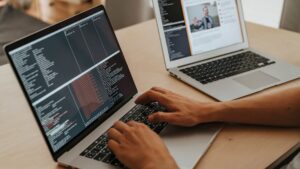Programming is an essential skill in today’s world, and mastering the basics is the first step toward success. Whether you want to build applications, develop websites, or work with data, understanding the fundamentals of coding will open many doors. In this blog, we present ten practical exercises designed to strengthen your programming foundation. These exercises are suitable for beginners and cover key topics such as logic, control structures, data handling, and functions.
1. Hello, World: Your First Program
The classic “Hello, World” is the starting point for anyone learning to code. It’s a simple but powerful exercise that introduces you to the basic syntax of a programming language.
Task
Write a program that prints “Hello, World” to the console. Then, experiment by changing the message to something else.
What You’ll Learn
- Basic usage of functions to print text.
- Familiarity with an Integrated Development Environment (IDE) or compiler.
2. Simple Addition Calculator
This exercise introduces input and output handling, as well as basic math operations.
Task
Write a program that asks the user for two numbers and displays their sum. For example:

What You’ll Learn
- Capturing user input.
- Basic arithmetic operations.
- Using variables to store data.
3. Odd or Even Numbers
Understanding control structures like conditionals is essential for writing dynamic programs.
Task
Create a program that asks the user for a number and determines whether it is odd or even. Use an if/else conditional to perform this check.
What You’ll Learn
- Using modular operators (e.g.,
%in Python). - Conditional structures.
- Basic programming logic.
4. Multiplication Tables
This exercise reinforces the use of loops, a key tool for repetitive tasks.
Task
Write a program that asks for a number and then prints its multiplication table up to 10. For example:

What You’ll Learn
fororwhileloops.- Efficient use of variables within loops.
- Generating dynamic outputs.
5. The Number Guessing Game
Simple games are an excellent way to practice logic and iterative structures.
Task
Develop a program where the computer generates a random number between 1 and 100, and the user has to guess it. The program should provide hints such as “Too high” or “Too low” until the user guesses correctly.
What You’ll Learn
- Using random functions.
- Flow control with loops and conditionals.
- Validating user input.
6. Average Calculator
Handling lists and performing operations on them is fundamental when working with data.
Task
Write a program that asks the user to enter several grades (using a list or array) and then calculates their average.
What You’ll Learn
- Using data structures like lists.
- Iterations to sum elements.
- Basic operations with stored data.
7. Reverse a String
This exercise improves your understanding of string manipulation and loops.
Task
Write a program that takes a word as input and returns its reversed version. For example:

What You’ll Learn
- Indexing and manipulating strings.
- Using loops to iterate through characters.
- Alternatively, using built-in string functions.
8. Count Vowels in a Sentence
Working with strings is a key skill, and this exercise will help you explore text manipulation further.
Task
Write a program that counts how many vowels are in a sentence entered by the user.
What You’ll Learn
- Filtering data within loops.
- Using conditions to compare characters.
- Optional: Differentiating between uppercase and lowercase letters.
9. Prime Numbers
Identifying prime numbers is an excellent exercise in logic and efficiency in programming.
Task
Create a program that determines if a given number is prime. A number is prime if it is divisible only by 1 and itself.
What You’ll Learn
- Efficient iterations to reduce the number of comparisons.
- Applying conditionals in mathematical problems.
- Optimizing basic algorithms.
10. Fibonacci up to N
The final exercise combines iterations and logic to generate sequences.
Task
Write a program that generates Fibonacci numbers up to a limit defined by the user. For example, if the limit is 10, the program should generate:

What You’ll Learn
- Using loops to generate numerical patterns.
- Maintaining states between iterations with variables.
- Working with user-defined limits.
Tips for Getting the Most Out of These Exercises
- Understand the Problem Before Coding: Make sure you fully understand what is being asked before you start writing code.
- Break the Problem Into Smaller Parts: If an exercise seems complex, break it down into simpler steps and tackle them one by one.
- Experiment: Play with the code. Modify things and observe what happens. Experimentation is a key part of learning.
- Research: If you get stuck, look up solutions or tutorials related to the problem online.
- Be Consistent: Regular practice is the key to becoming a better programmer.
Final Thoughts
Mastering the basics of programming is like building the foundation of a house: everything you do afterward depends on them. These exercises will not only help you develop technical skills but also improve your ability to solve problems and think logically. So open your code editor, pick an exercise, and start coding. The world of development is just a few lines of code away!




